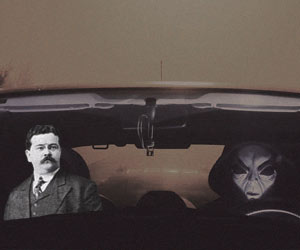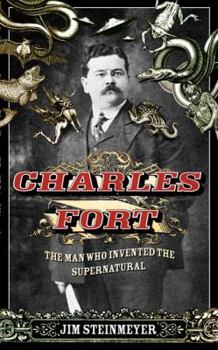Charles Fort: The Man Who Invented the Supernatural
Select Format
Select Condition 
Book Overview
The acclaimed and unforgettable true story of offbeat intellect and pioneering paranormal investigator Charles Fort--in paperback for the first time. Here is the seminal biography of one of the most... This description may be from another edition of this product.
Format:Hardcover
Language:English
ISBN:1585426407
ISBN13:9781585426409
Release Date:May 2008
Publisher:Tarcher
Length:332 Pages
Weight:1.10 lbs.
Dimensions:1.1" x 5.9" x 8.5"
Customer Reviews
5 ratings
Yet Another Reason I've Stopped Posting The Results of My Research On The Internet (from Ahadada Boo
Published by Thriftbooks.com User , 14 years ago
I've noticed that the fruits of my researches appear in books curiously devoid of my name. In the late 1990's and early years of this century, I made the mistake of posting articles on the Internet about Fort, and other unusual topics, and finding the content stripped of my name--not even a thank-you--and appearing under the "researches" of others. Case in point: this book, published in 2008. In 2000 I posted an article called "How Do We Pigeonhole that, Mr. Fort" at the website "Farshores" ([...]) in which I presented the excerpt from "Queer Books" that appears on page 191 of this volume, and which is "foot-noted" on pg 315, without so much as a thank you. How do I know that this "gentleman" did not stumble across the account himself? Because he follows my advice in the original article as it appears at Farshores, and later, on 17, March, 2004 on the Fortean Times message board, with annotations by "byroncac," who further helped the author of this book by providing from his own knowledge of Fort's life, including the letter to Dreiser. (See [...]) This author even paraphrases my annotations in the original article and takes my advice to consider Pearson the self-same librarian of which he writes. I have stopped posting my research on the net because the information develops long legs and leaves my name, and--incidentally-- my copyright--behind. Fort cited his sources correctly and I'm certain he would be just as livid over this as I am.
An Engaging Portrait of a Difficult Figure
Published by Thriftbooks.com User , 15 years ago
If you have a taste for giant lights in the sky or in the ocean, flying ships "shaped like a Mexican cigar", or secret polar civilizations; or especially, if you want to know more about how rain could come down colored red, black, or yellow, or could include a storm of eels or pebbles or frogs, then Charles Fort is your man. And if you want explanations, you might find it satisfactory that Fort instructs about the blood that dripped from the sky, "... our whole solar system is a living thing: that showers of blood upon this earth are its internal hemorrhages. - Or vast living things in the sky, as there are vast living things in the oceans..." Fort gets high points for curiosity, and no points for explication, but ninety years after his strange ideas were first put in print, his name is still known by students of the paranormal, whether the name be reviled or praised. In _Charles Fort: The Man Who Invented the Supernatural_ (Tarcher / Penguin), Jim Steinmeyer has given a jolly story of this remarkably strange man. Steinmeyer has written about various aspects of the history of magic, and he designs magic illusions for famous magicians, but this is an appreciative, no-nonsense biography, quite anomalously fitting for a subject who surrounded himself with at least some nonsensical tales taken as fact. Fort was born in 1874, and grew up in Albany, N.Y. His father was a grocer, a dandy, and a bully, and following a terrible row at home when he was eighteen, Fort left home for good to see the world. When he returned, he started writing stories for magazines, often in the popular vein of O. Henry. He had some success, got some stories published, but the pay was small. He was saved artistically by none other than the author of _An American Tragedy_, Theodore Dreiser, who became his best friend. It is strange that the dour Dreiser, famous for naturalistic and pessimistic fiction, should have admired Fort's stories, but when Fort began working on his strange metaphysics, Dreiser gave his estimation of Fort's genius as "simply stupendous", and he coached, corrected, and ushered Fort's work into print. Fort loved going to the library and researching, and he collected on scraps of paper any oddity that struck his fancy, phenomena that he designated beyond the explanatory power of science. Steinmeyer shows that Fort's speculations fit into the fizzy 1920s, and his book sold well. Fort insisted that "... nothing ever has been proved. Because there is nothing to prove." With everything all connected, the distinctions which science made were arbitrary and pointless. The _New York Tribune_ titled its laudatory review of the book "Science Mocked". Steinmeyer concedes that at a time when Gugliemo Marconi and Percival Lowell were telling the public about the endeavors of the Martians, Fort may have had a point. Generally, however, he had little real knowledge of how science worked, and his dismissal of science overall was fatuous. He was more appr
Fascinating Insights into an Odd Character
Published by Thriftbooks.com User , 15 years ago
Steinmeyer does a good job of encapsulating the life of Fort, who must not have been the easiest person to research. While a little short on Fort's actual motivation to catalog the world's oddest phenomena, the book provides fascinating accounts of Fort's troubled childhood, adult poverty, note-taking methodology and his strange and lengthy friendship with fellow author Theodore Dreiser. The subtitle "The Man Who Invented the Supernatural" is misleading, but I suspect it may not have been Steinmeyer's idea. It's a fast and curious look into the life of one our grand eccentrics.
Disturbing Portrait
Published by Thriftbooks.com User , 16 years ago
Magician and magical historian Jim Steinmeyer has written a carefully "agnostic" biography of that infamous agnostic of pseudoscience, Charles Hoy Fort. By this I mean that Steinmeyer essentially never intrudes with summations, analyses, judgments or conclusions... he gives the facts and lets them speak for themselves. In dealing with Fort, this is probably the correct approach. Fort was the product of a horrific childhood that would leave almost anyone seriously mentally ill, and indeed as an adult he found no part of society into which he could fit. Dropping out of high school (failing math and science, naturally) he worked as a newspaper reporter, and then tried to make a living as a writer of magazine fiction. His work during this period usually consisted of slice-of-life accounts (including one published novel) of daily existence in the slums and tenements of New York. At some point he turned to the writing of conventionally crazy pseudoscience, in the now-lost manuscripts he called X and Y. In X he argued that all life on earth is designed, evolved and controlled by intelligent creatures living on Mars. In Y he argued that there is a super-race living in a huge depression at the North Pole. In both works he used the technique familiar from Ignatius Donnelly (and later Immanuel Velikovsky), namely the backing of these wild claims by overwhelming (yet actually irrelevant) numbers of citations from obscure records and documents. Either manuscript could easily have been configured as science fiction, but despite hints from his good friend, novelist Theodore Dreiser, Fort refused to make the conversions. Neither was ever published in any form. Instead, an inheritance gave him leisure to write the four pseudoscience works for which he is best known, beginning with THE BOOK OF THE DAMNED. (He also appears to have written at least two other books in this vein, which he later destroyed, "M and F" and "WW".) The four published works follow the pattern of X and Y in consisting mainly of summaries of accounts of supposedly amazing phenomena, drawn from old magazines and newspapers, but differ in championing no particular scenario or hobbyhorse. They are well-written, in a somewhat annoyingly "cute" style, and often quite deliberately funny. Fort really started something, but it's difficult to say precisely just what. Most pseudoscience books of the 20th Century have had a superficially Fortean structure, but actually they jump back to Donnelly, using the structure to support just one particular crazy scenario. Fort is an important figure in the history of early 20th Century pure-quill craziness, and this carefully-researched biography is very welcome.
Riding on a comet...
Published by Thriftbooks.com User , 16 years ago
At last a major biography worthy of the man who introduced us to the truly amazing and inexplicable world we inhabit. Not since Damon Knight's 1970 bio has Fort been given his due. Fort came from an odd childhood of upper class indulgence and Dickensian cruelty perpetuated by his father. Fort's personal individuation was one of rebellion against social norms and mindless restrictions leading him to an "on the road" existence of travel, train yards, and down and outs from the backroads of America to cattle ships to Britain. Fort was Bohemia's bohemian who struggled as a newspaper reporter, starving novelist and hermit in a domestic life surrounded by his devoted wife and research notes. Theodore Drieser was the champion that finally realized the unique genius possessed by Fort and supported him with unwaivering friendship through the remainder of Fort's short but prolific life. But did he "invent" the supernatural as alleged by the title? Like an eccentric Zen master, Fort directly pointed at the documented realities that intrude into a well ordered empirical universe with distinctly uncomfortable implications. Continuing with the zen metaphor, Fort's "stick that heals" was one of curiosity and doubt. He had possessed a healthy minded agnosticism that was interested in everything because everything is interesting. Rather than "invent" Fort more accurately precipitated what has become known as the supernatural. Among the phenomena he documented were aerial phenonmena later to be called UFO's, vanishing lands, people, vessels and mysterious falls of substances that should not fall upon us are now pillars of the supernatural that continue to baffle and delight. Fort was a pioneer of an art and/or science that provided us with a lens to view the curious and wonderful world around us in ways not dreamed of in our philosophy. Mr. Steinmeyer, an established writer of magical wonders, is to be thanked for this work that brings the enigmatic Charles Fort to a new generation of readers and potential forteans. Highly recommended.
Charles Fort: The Man Who Invented the Supernatural Mentions in Our Blog

Celebrate National Paranormal Day with the Grand-Daddy of Oddball Inquiry, Charles Fort!
Published by Terry Fleming • May 01, 2019
In praise of National Paranormal Day (May 3), a day set aside to believe all those stories of supernatural stirrings and otherworldly oscillations you hear about throughout the year, allow me to introduce to you the Emperor of Eerie, Charles Fort!




